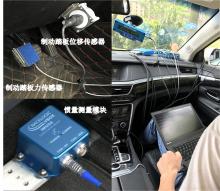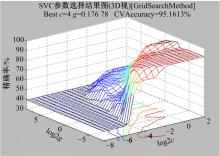Journal of Jilin University(Engineering and Technology Edition) ›› 2022, Vol. 52 ›› Issue (8): 1770-1776.doi: 10.13229/j.cnki.jdxbgxb20210187
Recognition method of braking intention based on support vector machine
- 1.School of Automotive and Traffic Engineering,Jiangsu University,Zhenjiang 212013,China
2.School of Automotive and Traffic Engineering,Jiangsu University of Technology,Changzhou 213001,China
CLC Number:
- U463.5
| 1 | 尘帅,王吉忠,张西龙,等. 面向车辆纵向动力学控制的制动意图识别综述[J]. 河北科技大学学报, 2019, 40(2): 105-111. |
| Chen Shuai, Wang Ji-zhong, Zhang Xi-long, et al. Overview of braking intention recognition for longitudinal dynamic control of vehicles[J]. Journal of Hebei University of Science and Technology, 2019, 40(2): 105-111. | |
| 2 | Kim I H, Kim J W, Haute S, et al. Detection of braking intention in diverse situations during simulated driving based on EEG feature combination[J]. Journal of Neural Engineering, 2015, 12(1): 016001. |
| 3 | Haufe S, Kim J W, Kim I H, et al. Electrophysiology-based detection of emergency braking intention in real-world driving[J]. Journal of Neural Engineering, 2014, 11(5): 056011. |
| 4 | Hernández L G, Mozos O M, Ferrández J M, et al. EEG-based detection of braking intention under different car driving conditions[J]. Frontiers in Neuroinformatics, 2018, 12(29): 1-14. |
| 5 | Teng T, Bi L Z, Liu Y L. EEG-based detection of driver emergency braking intention for brain-controlled vehicles[J]. IEEE Transactions on Intelligent Transportation Systems, 2018, 19(6): 1766-1773. |
| 6 | 乔丙辰. 基于驾驶员下肢表面肌电信号的紧急制动意图识别研究[D]. 武汉: 武汉理工大学自动化学院, 2019. |
| Qiao Bing-chen. Research on emergency braking intention recognition based on driver's lower limb EMG signal[D]. Wuhan: School of Automation, Wuhan University of Technology, 2019. | |
| 7 | 刘晏宇,喻凡,宋娟娟,等. 采用神经网络与模糊控制的制动需求识别[J]. 中国机械工程, 2020, 31(23): 2847-2855. |
| Liu Yan-yu, Yu Fan, Song Juan-juan, et al. Detection of brake requests using neural network and fuzzy control[J]. China Mechanical Engineering, 2020, 31(23): 2847-2855. | |
| 8 | 杨为,刘杰,周仕仕,等. 电动液压助力制动系统制动意图识别方法[J]. 重庆大学学报, 2021, 44(10): 1-12. |
| Yang Wei, Liu Jie, Zhou Shi-shi,et al. Braking intention identification for electric power hydraulic booster braking system[J]. Journal of Chongqing University, 2021, 44(10): 1-12. | |
| 9 | Zhao X, Wang S, Ma J, et al. Identification of driver's braking intention based on a hybrid model of GHMM and GGAP-RBFNN[J]. Neural Computing and Applications, 2018, 31: 161-174. |
| 10 | 王波,唐先智,王连东, 等. 基于EEMD和熵理论的电动汽车制动意图识别方法[J]. 汽车工程, 2018, 40(8): 936-941. |
| Wang Bo, Tang Xian-zhi, Wang Lian-dong, et al. Braking intention identification method for electric vehicles based on EEMD and entropy theory[J]. Automotive Engineering, 2018, 40(8): 936-941. | |
| 11 | 潘宁, 于良耀,宋健. 考虑舒适性的电动汽车制动意图分类与识别方法[J]. 清华大学学报: 自然科学版, 2016, 56(10): 1097-1103. |
| Pan Ning, Yu Liang-yao, Song Jian. Braking intention classification and identification considering braking comfort for electric vehicle[J]. Journal of Tsinghua University(Science and Technology), 2016, 56(10): 1097-1103. | |
| 12 | 曲代丽. 基于模糊神经网络的驾驶员制动意图辨识技术研究[D]. 长春: 长春工业大学机电工程学院, 2016. |
| Qu Dai-li. Research on identification technology of driver's braking intention based on fuzzy neural network[D]. Changchun: School of Mechanical and Electrical Engineering, Changchun University of Technology, 2016. | |
| 13 | 王骏骋,何仁. 面向全制动工况的液压制动双环预测控制策略[J]. 吉林大学学报: 工学版, 2020, 50(3): 820-833. |
| Wang Jun-cheng, He Ren. Double-loop predictive control scheme of hydraulic braking system for all braking conditions[J]. Journal of Jilin University(Engineering and Technology Edition), 2020, 50(3): 820-833. | |
| 14 | 王庆年,王俊,陈慧勇,等. 混合动力车辆中的加速与制动意图识别[J]. 吉林大学学报: 工学版, 2014, 44(2): 281-286. |
| Wang Qing-nian, Wang Jun, Chen Hui-yong, et al. Accelerating and braking intention identification in hybrid vehicle[J]. Journal of Jilin University(Engineering and Technology Edition), 2014, 44(2): 281-286. | |
| 15 | 谷新平,韩云鹏,于俊甫. 基于决策机理与支持向量机的车辆换道决策模型[J]. 哈尔滨工业大学学报, 2020, 52(7): 111-121. |
| Gu Xin-ping, Han Yun-peng, Yu Jun-fu, et al. Vehicle lane-changing decision model based on decision mechanism and support vector machine[J]. Journal of Harbin Institute of Technology, 2020, 52(7): 111-121. | |
| 16 | 张元侠. 基于SVM学习模型的换挡决策研究[D]. 长春: 吉林大学汽车工程学院, 2019. |
| Zhang Yuan-xia. Research on gear shift decision based on SVM learning model[D]. Changchun: College of Automotive Engineering, Jilin University, 2019. | |
| 17 | 李航. 统计学习方法[M]. 北京: 清华大学出版社, 2012. |
| Li Hang. Statistical Learning Methods[M]. Beijing: Tsinghua University Press, 2012. |
| [1] | Han-wu LIU,Yu-long LEI,Xiao-feng YIN,Yao FU,Xing-zhong LI. Multi⁃point control strategy optimization for auxiliary power unit of range⁃extended electric vehicle [J]. Journal of Jilin University(Engineering and Technology Edition), 2022, 52(8): 1741-1750. |
| [2] | Jun-cheng WANG,Lin-feng LYU,Jian-min LI,Jie-yu REN. Optimal sliding mode ABS control for electro⁃hydraulic composite braking of distributed driven electric vehicle [J]. Journal of Jilin University(Engineering and Technology Edition), 2022, 52(8): 1751-1758. |
| [3] | Qing GAO,Hao-dong WANG,Yu-bin LIU,Shi JIN,Yu CHEN. Experimental analysis on spray mode of power battery emergency cooling [J]. Journal of Jilin University(Engineering and Technology Edition), 2022, 52(8): 1733-1740. |
| [4] | Shuai HAO,Chuan-tai CHENG,Jun-nian WANG,Jun-yuan ZHANG,You YU. Ergonomic optimization and test evaluation of sports SUV cockpit layout design [J]. Journal of Jilin University(Engineering and Technology Edition), 2022, 52(7): 1477-1488. |
| [5] | Jia-xu ZHANG,Chong GUO,Chen WANG,Jian ZHAO,Xin-zhi WANG. Performance evaluation of automatic parking system based on hardware in the loop simulation platform [J]. Journal of Jilin University(Engineering and Technology Edition), 2022, 52(7): 1552-1560. |
| [6] | Hong-bo YANG,Wen-ku SHI,Zhi-yong CHEN,Nian-cheng GUO,Yan-yan ZHAO. Optimization of tooth surface modification based on a two-stage reduction gear system [J]. Journal of Jilin University(Engineering and Technology Edition), 2022, 52(7): 1541-1551. |
| [7] | Guang-ming NIE,Bo XIE,Yan-tao TIAN. Design of cooperative adaptive cruise control algorithm based on Frenet framework [J]. Journal of Jilin University(Engineering and Technology Edition), 2022, 52(7): 1687-1695. |
| [8] | Chen HUA,Run-xin NIU,Biao YU. Methods and applications of ground vehicle mobility evaluation [J]. Journal of Jilin University(Engineering and Technology Edition), 2022, 52(6): 1229-1244. |
| [9] | Xiong LI,Feng-chong LAN,Ji-qing CHEN,Fang TONG. Comparison of injuries in front impact between Hybird III dummy model and CHUBM human biomechanical model [J]. Journal of Jilin University(Engineering and Technology Edition), 2022, 52(6): 1264-1272. |
| [10] | Ying-chao ZHANG,Yun-hang LI,Zi-yu GUO,Guo-hua WANG,Zhe ZHANG,Chang SU. Optimization of the aerodynamic drag reduction of a cab behind engine vehicle [J]. Journal of Jilin University(Engineering and Technology Edition), 2022, 52(4): 745-753. |
| [11] | Wen-ku SHI,Shu-guang ZHANG,You-kun ZHANG,Zhi-yong CHEN,Yi-fei JIANG,Bin-bin LIN. Parameter identification of magnetorheological damper model with modified seagull optimization algorithm [J]. Journal of Jilin University(Engineering and Technology Edition), 2022, 52(4): 764-772. |
| [12] | Jie LI,Tao CHEN,Wen-cui GUO,Qi ZHAO. Pseudo excitation method of vehicle non-stationary random vibration in space domain and its application [J]. Journal of Jilin University(Engineering and Technology Edition), 2022, 52(4): 738-744. |
| [13] | Wei LI,Hai-sheng SONG,Hao-yu LU,Wen-ku SHI,Qiang WANG,Xiao-jun WANG. Linear identification method of hysteresis characteristic of composite leaf springs [J]. Journal of Jilin University(Engineering and Technology Edition), 2022, 52(4): 829-836. |
| [14] | Wei-min ZHUANG,Shen CHEN,Di WU. Influence of strengthening form of CFRP on transverse impact performance of steel tube [J]. Journal of Jilin University(Engineering and Technology Edition), 2022, 52(4): 819-828. |
| [15] | Wei LUO,Bo LU,Fei CHEN,Teng MA. Fault diagnosis method of NC turret based on PSO⁃SVM and time sequence [J]. Journal of Jilin University(Engineering and Technology Edition), 2022, 52(2): 392-399. |
|
||




